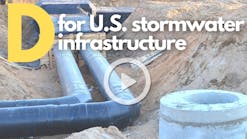Effective stormwater management and flood prevention efforts in the United States rely heavily on proper permitting. Compliance with various regulations and guidelines affects how companies and municipalities manage stormwater permitting and its associated responsibilities. These regulations and policies are in place to ensure that flooding and stormwater runoff is appropriately managed and does not cause environmental damage or harm to human health or loss of property. Compliance with the various stormwater permitting requirements and associated responsibilities can be complex and time-consuming. Still, failure to comply with these regulations can result in fines and penalties.
For example, let’s take a closer look at the new proposed stormwater rules in New Jersey. The new proposed stormwater rules in New Jersey can serve as a case study to examine the broader issues and challenges facing the stormwater industry in other parts of the country. The state is taking significant steps to update its stormwater permitting rules, including raising the minimum required flood hazard elevation to reduce the risk of inland flooding.
Under new proposed regulations, expected to take place later this year, the fluvial design flood elevation would be set at two feet above the NJDEP Flood elevation and one foot above the Federal Emergency Management Agency’s (FEMA) 100-year elevation. The changes will impact development at large, municipal stormwater ordinances. Non-compliance with the proposed Flood Hazard and Stormwater rules will result in hefty fines and penalties.
However, there are some concerns about the potential impact of these changes, particularly on the construction industry. Builders’ associations are fighting the rules, as they could limit development, which would ultimately affect the economy in the state of New Jersey. There are also concerns about the financial implications of the rules for homeowners, who may be required to purchase flood insurance to cover themselves in the event of flooding. The rules could also limit building expansion and amenities in regulated floodplains.
New Jersey’s floodplain manager plays an essential role in the permit and compliance process for the proposed new stormwater rules in New Jersey. They coordinate between the New Jersey Department of Environmental Protection (NJDEP), FEMA, Army Corps of Engineers, and all the municipalities comply with the new rules. Ultimately, the intent is to limit repeated loss of property, improve water quality, erosion standards and control pollution.
New Jersey's approach
The state’s stormwater management and flood prevention strategy is centered on green infrastructure, which uses natural systems like trees, plants and soil to trap and filter stormwater. Green infrastructure can collect and treat stormwater through rain gardens, green roofs and permeable pavement, lowering runoff and averting floods. By integrating these techniques into new and renovated projects, New Jersey has successfully minimized the impact of stormwater on the state's waterways and averted flooding in at-risk regions.
One of the critical factors contributing to New Jersey's success in stormwater management and flood prevention is its regulatory approach. The state has developed a comprehensive set of regulations enforced by the NJDEP, which oversees the implementation of the state's Flood Hazard and Stormwater Management Rules. These rules require that all new development and redevelopment projects meet strict stormwater management requirements and that existing developments be retrofitted with green infrastructure practices and techniques to capture and treat stormwater.
In addition to its regulatory framework, New Jersey has also developed several programs to support the implementation of stormwater management and flood prevention measures. For example, the state’s Green Acres program provides funding to municipalities and nonprofits for the acquisition and development of open space, which can be used for stormwater management and flood prevention. The state’s Clean Water State Revolving Fund provides low-interest loans to municipalities and other entities for the construction of stormwater management projects.
Ideas from other states
In neighboring Pennsylvania, the Keystone State’s Stormwater Management Act (Act 167) was enacted in 1978 to provide a framework for stormwater management in the Commonwealth. The law requires municipalities to develop and implement stormwater management plans specific to the local watershed and meet the state's stormwater regulations requirements. The law aims to reduce the adverse impacts of stormwater runoff on the environment and protect public health and safety. The law also requires municipalities to provide public outreach and education programs to promote stormwater management practices to residents and businesses.
Meanwhile, Ohio’s current stormwater management standards were adopted in 2021, and the state will still need to update them. As a result, there may be gaps in the rules that must address emerging challenges, such as new pollutants, changes in land use and climate change. On the West Coast, California’s stormwater management rules still need help to keep up with changing environmental conditions and emerging contaminants, despite having some of the strictest stormwater regulations in the country. In Florida, there is a high risk of flooding due to its geography and weather patterns, which make effective stormwater management critical. However, the state’s regulations vary widely across different municipalities, making it difficult to ensure consistent and effective stormwater management statewide.
Managing stormwater nationwide
Back in New Jersey, proposed regulations and how they roll out can teach us a lot about how to manage these issues nationwide. These regulations aim to limit repeated loss of property, improve water quality and erosion standards, control pollution and prevent flooding. While they may have some short-term financial implications, the long-term benefits of reducing the risk of flooding and improving the environment will likely outweigh the costs.
For manage compliance and permitting issues, here are 10 consulting practices that can help:
- Know and understand the regulations and stay ahead of new regulatory proposals. New regulations do not appear overnight — there is typically a public comment process during which stakeholders can provide feedback and input. By actively participating in this process and staying informed about proposed regulations, businesses can prepare for changes in advance.
- Keep clients informed and aware of potential delays or redesign needs. We typically have regular standing meetings with clients in which we discuss project updates, timelines, and any issues or challenges that could arise.
- Build strong relationships with regulators and enforcement officials. In some cases, we and our clients have relationships and friendships that go back decades. Attending networking events, public hearings, and other industry events can be a valuable way to connect with regulators and enforcement officials and build strong relationships. By attending these events, we can gain a better understanding of the regulatory landscape.
- Communicate worst-case scenarios and options to manage compliance. Legal and financial issues might come up, and it is important to communicate these scenarios with clients.
- Explain regulatory implications and impacts of policy deviations. By explaining the regulatory implications and impacts of policy deviations, we can provide clients with insights into how deviations from policies can negatively impact their reputation and business operations.
- Alert clients to permit expiration dates in advance to avoid lapses. Our clients and stakeholders are counting on us to keep our calendars current.
- Be strategic in regulatory approaches to maximize project delivery. We can help clients navigate any regulatory hurdles or uncertainties that may arise, providing them with a clear path forward to achieving their project goals.
- Meet with reviewers to discuss projects and avoid delays. By proactively addressing concerns about delays, we can help ensure that projects are reviewed and approved in a timely manner.
- Inform clients of their errors and develop a strategy with regulators to avoid fines. By taking a forward-thinking approach and working collaboratively with regulators to develop a remediation plan, we can help mitigate the impact of any errors and ensure that our clients comply with relevant regulations.
- Manage client expectations for a complex and lengthy regulatory process. By providing clients with regular updates on the progress of their project and any potential delays or challenges that may arise, we can help them stay informed and engaged throughout the process.
These best practices for managing compliance and permitting issues have practical applications for specific projects. Ultimately, it is everyone’s responsibility to prioritize compliance with stormwater permitting requirements to protect our environment and promote the well-being of our communities.
------------------------------
Kristopher Krzyston is a vice president, Regional Environmental Practice Leader at T&M Associates. Krzyston can be reached at [email protected].
Kristopher Krzyston
Kristopher Krzyston is a vice president, Regional Environmental Practice Leader at T&M Associates. Krzyston can be reached at [email protected].






